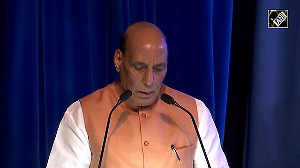Bhargav is a prototype of the e-age generation. He is neck-deep in debt and couldn't even afford to pay his monthly mobile bill of Rs 5,000, which is higher than the usual Rs 3,000.
His penthouse, Compaq computer, LG television, Hitachi air-conditioner, leather sofa and Ford Fiesta speak volumes for his debt-friendly nature. Shelling out an extra Rs 2,000 will throw his other monthly repayments completely out of whack.
Which is why he's running to the bank for a loan -- and banks are welcoming people like him with open arms. For an entire generation of young Indians, "buy now, pay later" seems to have become the new mantra.
Be it a new refrigerator or some other household appliance, a wedding in the family or a foreign vacation, if you do not have liquidity, just walk into a bank and get the money you need.
According to bankers, the genesis of the "credit culture" can be traced back to around 2001, when interest rates crashed, creating a whole new business opportunity -- the personal loan. Industry sources point out that the average outgo towards EMIs (equal monthly installments) has increased significantly.
Any borrower, if single, shells out 60 to 70 per cent of his salary towards the cost of his live-on credit culture. Married couples keep the EMI outgos at about 40 per cent of their salaries.
Recall the famous speech of Hindustan Lever's M S Banga, in which he blamed the declining fortunes of the FMCG major to customers' shift to lower-priced brands as savings were being diverted to repay EMIs for consumer durables, mobile usage and spends on entertainment and travel. This led to downtrading, where consumers started looking for more value-for-money products, said Banga.
This is a typical phenomenon of developing economy, say bankers. The domestic housing loan market and the auto loan market has posted a year-on-year growth of 35 to 40 per cent. On the other hand, the unsecured personal loan market has grown by 50 per cent since 2002.
"The times are changing. Thanks to the attitude change as far as indebtedness is concerned, now borrowing is no longer viewed negatively," agrees a loan manager.
The boom in consumer loans is certainly not bothering banks as they have confidence in their risk assessment models.
"Over time, banks have also equipped themselves with the required skill-sets to evaluate the credit worthiness of customers. There is no systemic risk involved in unsecured lending," the loan manager adds.
Financial planners, however, suggest that a borrower should ensure that his total financial liability doesn't exceed more than 60 per cent of his take-home salary. If an individual breaches this limit, it could be disastrous not only for him/her but also for the banks and the financial system.
As American business tycoon John Paul Getty said, "If a customer borrows $100 from a bank, it's his problem. But if he borrows $100 million from a bank, it is the banker's problem!"
Do you want to discuss stock tips? Do you know a hot one? Join the Stock Market Discussion Group.







 © 2025
© 2025